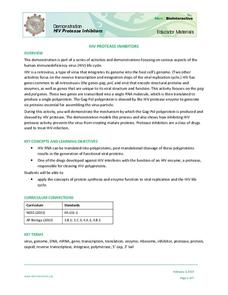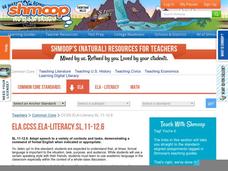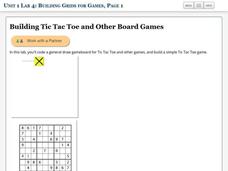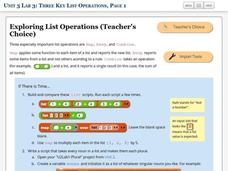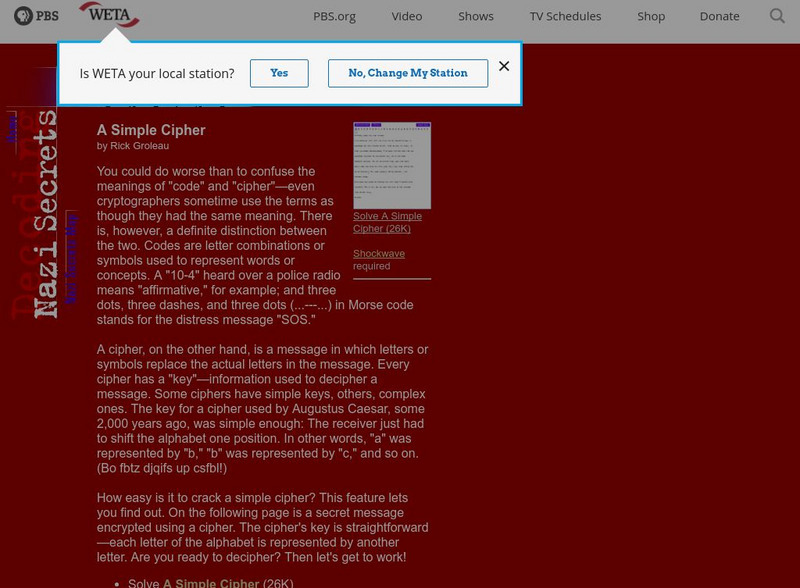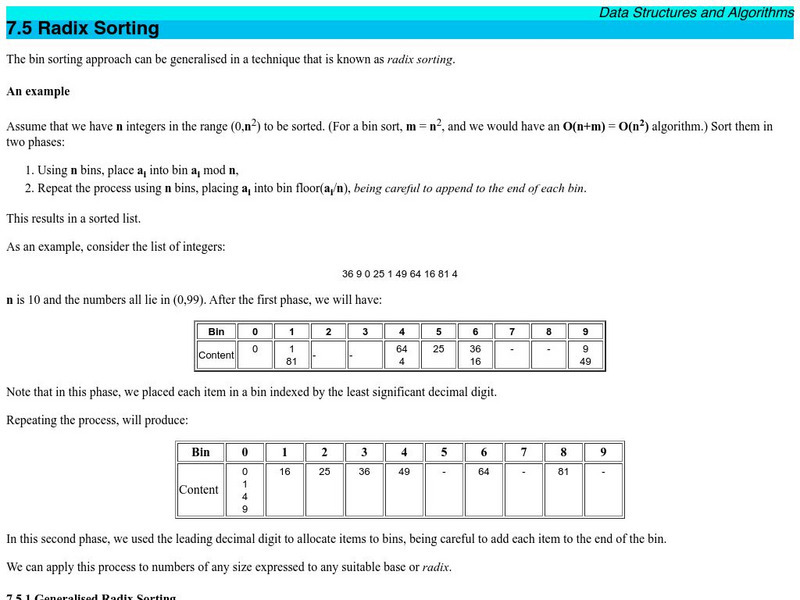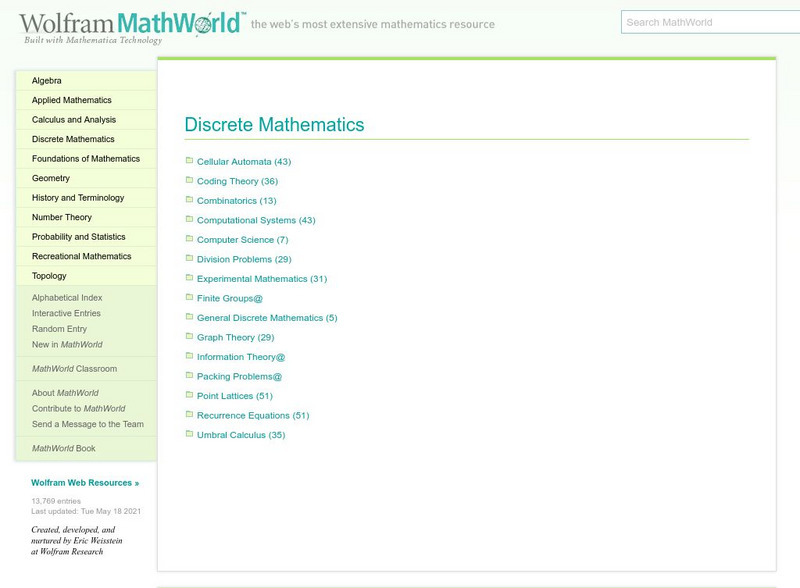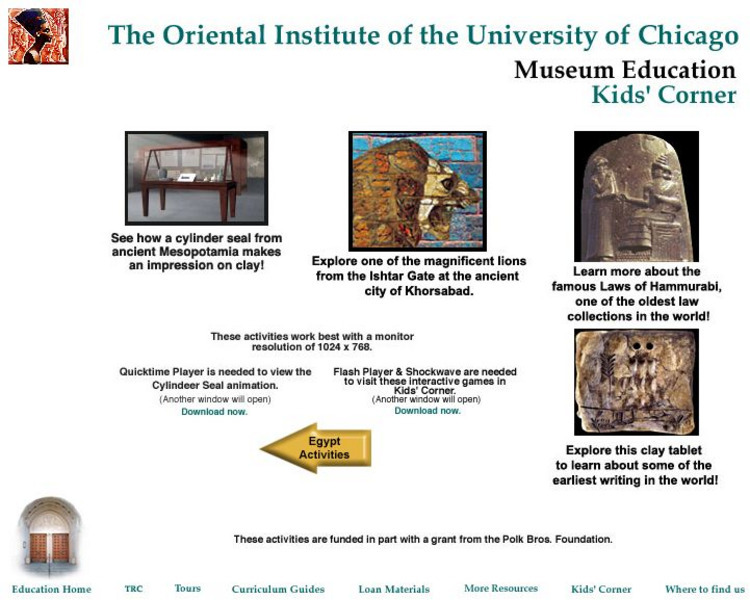Howard Hughes Medical Institute
HIV Protease Inhibitors
How do doctors fight a virus that's constantly mutating? Show science scholars how we fight HIV using one of its own most fundamental processes through a thoughtful demonstration. The lesson focuses on how protease inhibitors prevent HIV...
Beauty and Joy of Computing
Building Your Own Blocks
Isn't building with blocks an activity for toddlers? The third lab of a five-part unit teaches young computer scientists how to create their own block instructions for programming. They use these blocks to create geometric figures, spell...
Beauty and Joy of Computing
Combining List Operations
Use list operations to modify an earlier version of Tic Tac Toe. The fourth lab in a series of five has pupils combine list operations to build more powerful operations. They take a project from a previous unit and enhance it to keep...
Shmoop
ELA.CCSS.ELA-Literacy.SL.11-12.6
Sometimes it's all too easy to slip into informal language, ya know? Help your class master code-switching with the activity and drill provided here. The activity is a literature discussion where formal language is required. The...
Curated OER
Implications of the Human Genome Project
Students study the Human Genome Project through classroom discussion and the video, Cracking the Code of Life. They research reports about the issues of disease, human health, and the ethical, legal, and societal implications of the...
Beauty and Joy of Computing
Algorithms
Introduces the class to the idea of searching a list by building a script. Learners modify a guessing game script that will find a number in a list.
Beauty and Joy of Computing
Building Grids for Games
You can't play Tic Tac Toe without grids. In the fourth lab of a five-part unit, scholars learn how to build grids for games such as Tic Tac Toe. Along the way, they also learn about reporter blocks that perform calculations.
Beauty and Joy of Computing
Conditional Blocks
If you use the resource, then pupils will understand conditional block instructions. In the first lab of a six-part unit, pupils learn how to use conditional statements (if/then) in block instructions for computer programming. They apply...
Beauty and Joy of Computing
Nesting Lists
Create lists within lists. The second lab in a series of five in the unit has pupils develop a simple contact list app. The tasks within the lab build the need for an abstract data type. Individuals build more complexity into their...
Beauty and Joy of Computing
Three Key List Operations
Develop an understanding of the Map, Keep, and Combine operations. The lab leads the class through the exploration of three list operations. Each task contains a self-check to measure scholars' understanding of the operation in the...
Beauty and Joy of Computing
Search Engines
Which search engine is best? The last lab in a unit of five leads the class to investigate search engines. Working in groups, individuals read and discuss articles related to searching the Internet. Pupils develop suggestions that...
Beauty and Joy of Computing
Unsolvable and Undecidable Problems
Try as you might, some functions just cannot be computed. The lab introduces the class to the possibility of unsolvable problems. The fourth lesson in a series of seven begins with a logic problem, then progresses to looking at functions...
Teach Engineering
DNA Forensics and Color Pigments
Use food coloring in electrophoresis. The last segment in a four-part series mimics DNA fingerprinting by using chromatography. Teams conduct chromatography on food coloring to find colors that use similar pigmentation in their makeup.
PBS
Pbs Nova: Decipher a Coded Message
The basic difference between a code and cipher is explained briefly. You can try to crack a simple cipher at this location.
PBS
Pbs Teachers: Cracking the Code: Explore a Stretch of Code
Investigate the makeup and function of genes and genetic code by exploring an actual stretch of human DNA in this activity.
US National Archives
Nara: Presidential Election Laws: Presidential Election Laws
Check out this site from the National Archives and Records Administration on the US Constitution and the United States Code for laws and provisions regarding presidential elections.
CK-12 Foundation
Ck 12: Plix: Genetic Code
[Free Registration/Login Required] Synthesize a protein by dragging the amino acids to the corresponding codon on the mRNA segment. You will need a sign-in to access this interactive but it will be well worth your time!
PBS
Pbs Nova: A Simple Cipher
The difference between a code and cipher is explained. See if you can solve a simple cipher challenge at the bottom of the page.
University of Auckland School of Computer Science
Morris: Radix Sorting
A detailed description of the Radix sort algorithm, including a code solution written in the C programming language and an interactive animation / visualization of the sort at work.
Wolfram Research
Wolfram Math World: Discrete Mathematics Topics List
A thorough list of topics in the study of Discrete Mathematics. Combinatorics, Graph Theory, and Point Lattices are three of the many areas given in-depth explanations here. Many of the links contain discussions of the topics that both...
CK-12 Foundation
Ck 12: Plix: Punnett Squares
[Free Registration/Login Required] Use the color coding to help you complete the Punnett Square. You will need a sign-in to help you access this media, but it will be worth your time!
CK-12 Foundation
Ck 12: Plix: Anaerobic vs. Aerobic Respiration: Types of Respiration
[Free Registration/Login Required] Fill in the concept map regarding respiration, anaerobic and aerobic, to test your knowledge of the different types. You will need a sign in code to access this media but it is worth it!
University of Chicago
Museum Education: Kids' Corner
An interactive examination of artifacts from Mesopotamia. Find out about early writing, the code of Hammurabi, and cylinder seals.
Other
Clemson University: Soil Acidity and Liming
Covers the composition and uses of liming materials in agriculture, as well as the lime codes of several states. Good definitions of terms: lime, calcitic limestone, calcite, dolomite, dolomitic limestone, aragonite, hi-cal lime, and more.
